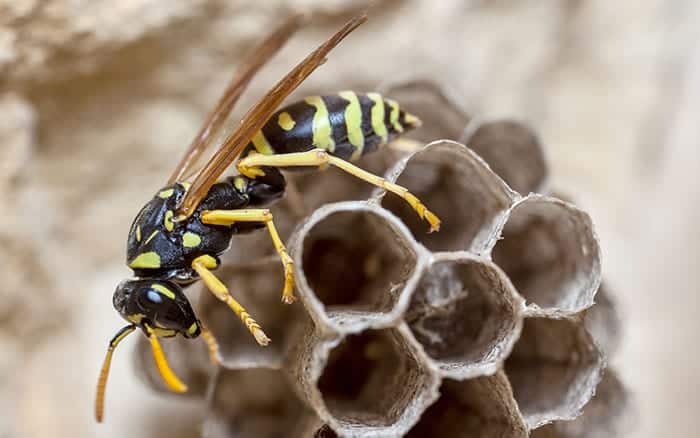Wasps are an inevitable source of annoyance to any summer gardener. Often aggressive and with a nasty sting in the tail, many people turn to chemical repellents as a wasp deterrent to rid their gardens of these banded nuisances.
While wasps do have an important role in the world, such as pollinating plants and preying upon common garden pests like aphids and caterpillars, they often play the more annoying role of aggravating pest by buzzing around our BBQs and making nests in awkward places. With that in mind, here are 3 wasp deterrrent tips for your garden this summer:
Here are my top 3 tips to help you keep your garden wasp-free this summer
1. Preparation
There are two types of wasp in the UK: Solitary wasps, which live and work alone and social wasps, which live in large colonies. Solitary wasps primarily hunt other insects and it is the social wasps, like the Vespula vulgaris (common wasp), which are likely to pester us at summer picnics.



The best way to deter social wasps from your garden is preparation, which means removing anything that is likely to attract them.
The lifecycle of a wasp determines the type of behaviour they exhibit at different times of the year. For example, at the beginning of summer, wasps are busy collecting materials to build their nests and this makes them hungry for protein.
If you have a BBQ, a picnic or an Al fresco sandwich, make sure to clear away anything with meat on it, such as a used grill or leftover food. Towards the end of summer, wasps tend to switch their attention to anything sweet.

This is because their purpose as workers for the queen is coming to an end, as she will soon enter hibernation, leaving the workers to binge on sweet foods before they die. So, make sure you cover up any sweet foods and drinks and remove fallen fruit. You could also switch to diet drinks, which don’t contain sugar, as these will be less attractive to sugar-seeking wasps.
If you are wearing bright clothes, you may be mistaken for a flower, especially if you’re wearing fragrant products such as perfume, hairspray or used strong shampoo. Although there’s not one single colour that will repel wasps, wearing pale or light shades is your best bet to not attract them.

2. Use wasp-deterring plants
Another good way to deter wasps in your garden, is to plant herbs and flowers that wasps hate. The great thing about these deterrents is that many of them are useful herbs or beautiful flowers, that look and smell amazing. Wasps have an amazing sense of smell and detest the powerful odour of some fragrant plants.



Fragrant herbs, such as Artemisia absinthium (Wormwood), Mentha spicata (Spearmint) and Thymus vulgaris (Thyme) are all good wasp deterrents and great for cooking too!
Ever smelt the scent of bright and refreshing Eucalyptus leaves? You can see why Koalas love them… Wasps, on the other hand, hate them.
With its strong, fragrant aroma, Cymbopogon (Lemongrass) is another plant that wasps cannot stand and will readily avoid.
For a deterrent that doubles as a beautiful flower display, plant Mentha pulegium (Pennyroyals), Geraniums and Calendula (Marigolds), as these will brighten up the garden while keeping the buzzing at bay, leaving you to enjoy the garden in peace.

Love the sight of Foeniculum vulgare (Sweet Fennel), Daucus carota (Queen Anne’s Lace) and Achillea millefolium (Yarrow)? Well, unfortunately wasps love them too. So, if you aren’t keen on attracting more wasps into your garden, then maybe these aren’t the right plants for you.

3. Create your own decoy wasp’s nest
A more creative way of deterring wasps from your garden, is to make, or purchase a decoy wasp’s nest. Wasps are territorial insects and, in most cases, will not visit areas where a rival nest is already established. The decoy nest works like a scarecrow, by tricking the wasps into thinking it is an enemy nest which they will be keen to avoid.
Why not get the kids to have a go at making their own decoy nests? It’s great fun and will also help to keep you garden wasp-free. You can use a range of materials to make your own decoy, but the best technique is to build one using papier-mâché as it will look the most realistic.

For this you will need:
– Flour and water paste (approx. 1-part flour to 1-part water) or PVA glue
– Strips of brown paper or newspaper
– An inflated balloon
– String
Fact:
The largest wasp nest ever recorded was found in New Zealand in 1963 and was 12ft by 6ft!



To begin, simply dip the strips of paper into the flour and water paste. Then lay the strips across the balloon horizontally to mimic the ridged construction of a real wasp’s nest. Do this until the balloon is completely covered and then leave to dry and harden. The balloon inside will deflate on its own over time, or it can be popped and pulled out through the bottom. Use the string to tie the nest to a wall-hook or tree branch and hopefully you won’t have to put up with as many aerial intrusions.
Alternatively, you can purchase commercial decoy wasps nest from garden centres or online.


Thank you so much. We have just built a new deck and the wasps have been a real problem. I will try all of your suggestions for next year
I was having problems with wasps munching on my garden furniture . I looked online for an insect friendly repellent and found this article.
I bought spearmint essential oil and put a few drops into a spray bottle filled with water. I sprayed all of the wooden furniture in the garden and the holes where the wasps were congregating.
That was 2 days ago, no sign of wasps since happy days.